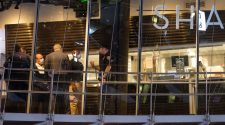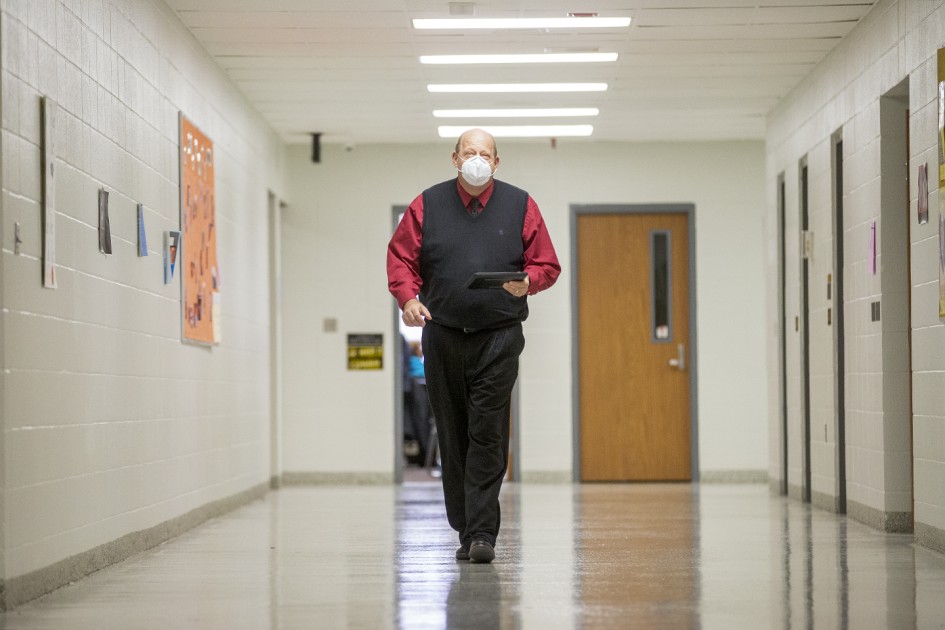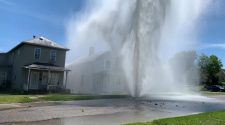Some three decades ago, Doug Vander Linden, who had always planned on a career in education, was working a corporate gig, when a one-paragraph job posting caught his eye: The Burlington, Kan., school district wanted a “technology facilitator” to help develop a plan for using new tools at a time when computers in classrooms were still a relatively recent phenomenon.
Over the years that followed, Vander Linden has watched education technology grow from a sideshow into a critical vehicle for delivering instruction and preparing students for the workforce.
He’s overseen the nearly 1,000-student district’s gradual move from a handful of Apple 2Es—the great-granddaddy of today’s sleek MacBooks—to a sprawling 1-to-1 device program with nearly 1,000 devices. He’s led the way in developing the district’s technology curriculum, which is continually updated. He’s spearheaded efforts to help teachers get training on how to incorporate technology in the classroom.
And perhaps most crucially, he’s helped Burlington, a small rural district in eastern Kansas, develop the kind of high-speed connectivity that enables its students to take advantage of a broader range of virtual learning opportunities than those at many other school systems of a similar size and location.
Nominate a Leader
Do you know a school district leader who has brought fresh, successful ideas to their school community? Tell us about them.
Vander Linden isn’t just a tech guy. He’s been the head wrestling coach at Burlington High School for 30 years. And he’s held leadership positions in high school wrestling both in Kansas and nationally, even as that sport evolves: In 2019, he was on a state task force that helped make girls’ wrestling a sanctioned high school sport.
It’s tough to put something like fiber optic cable in the same sentence as, say, a half nelson. But Vander Linden sees a clear connection between his work as a technology guru and his coaching gig.
“Wrestling is about hard work, perseverance, dedication. It’s about goal setting,” he said. “We let life pin us down and we feel sorry for ourselves, and that creates a pattern. Wrestling is the ultimate example of that in sports. … To be successful as an education administrator, as a wrestling coach, you have to come up with a shared vision.”
A ‘field of dreams’ gamble pays off
Back in 1994, Vander Linden helped get the district—and several of its neighbors—on board with an innovative idea that is still paying dividends for Burlington. He was intrigued by the power of technology to transform instruction and offer more options to students, particularly those who lived in small towns like Burlington. But at that point, Burlington’s internet simply didn’t have the speed to handle things like interactive online courses. And the cost of running fiber optic cable from the closest service center, some 90 miles away, would have been tough for the small district to swallow on its own, he said.
So Vander Linden teamed up with other local leaders and created a network that would help the entire county stay connected by pooling costs. The Coffey County Area Network, or CoffeyCAN, includes three school districts, six public libraries, six medical facilities, and all of the county government buildings.
Lessons From the Leader
- Have a Shared, Compelling Vision: The vision—whether for technology, teacher training, a new initiative, a school building, or your athletic team—should be one that a collective of people can agree moves the organization forward and inspires action.
- Surround Yourself With Great Teams: When serving on any team, remember that the roles are dynamic. Each project requires that responsibilities, from leader to worker, shift for the various team members.
- Strive to Be a Servant-Leader: Understand that leadership is not about status; it is about serving others. As a technology leader, we talk about 24 x 7 x 365: Our systems will be up 24 hours a day, 7 days a week, 365 days a year. Our job is to serve our teachers, administrators, staff, students, and our educational community.
In the 1990s, the group only had an inkling of what the network could accomplish. It was a “field of dreams” mentality, Vander Linden recalled: “We hadn’t even envisioned what great teachers, great education people [could] come up with for this network. They don’t know what those great ideas are until they have the network in place to begin with those ideas. If you build it they will come.”
Vander Linden has helped lead efforts to upgrade the system through the next two and a half decades, to make sure it continues to meet Burlington’s needs.
CoffeyCAN might sound like something straight out of a Folgers commercial, as Vander Linden acknowledges, but over its 25-year history, the network has made it possible for every student to stream video or participate in digital lessons at the same time.
The district has been able to “take students on [virtual] field trips,” across the nation, Vander Linden said. “It’s truly two-way interactive distance learning.”
From the comfort of their classrooms, students have been able to visit the Mark Twain House and Museum in Hartford, Conn., the Cleveland Institute of Art in Ohio, and the National Baseball Hall of Fame in Cooperstown, N.Y. One high school in the county uses the network to bring in physics and Spanish instruction remotely, since officials don’t have the budget to hire separate teachers for those subjects.
“We can easily create an interactive distance learning environment at the drop of a hat,” Vander Linden said. “It has allowed us from this small rural county in Kansas [to] connect across the nation to a variety of learning resources.”
COVID-19 puts the network to the test
These days the network allows the district—and its neighbors—a level of network performance that many small, remote school systems envy.
Nationwide, just 48 percent of districts currently provide the target bandwidth of 1 megabit per second, per student in the classroom, according to a November 2020 report by the nonprofit Connected Nation (formerly EducationSuperHighway) and Funds for Learning, a consulting group, both of which have helped lead a decade-long push to improve school connectivity. Small rural school districts especially struggle with this issue.
Propping up those fast speeds is the unglamorous but critical work of building infrastructure. CoffeyCAN has been able to purchase two internet pipes extending to different geographic areas—Kansas City to the northeast and Wichita to the southwest. That means if there is a cable cut in the Kansas City metro location, Burlington isn’t “down for hours or even days,” Vander Linden explained, because there is another pipe in the opposite direction.
I tell everybody, we have the technology infrastructure of a Fortune 500 company, even though we are very small in comparison.
“There are redundancies that we have been able to put in place that small organizations would not have the ability to do,” Vander Liden said. “I tell everybody we have the technology infrastructure of a Fortune 500 company, even though we are very small in comparison, individually.”
Possibly the network’s greatest test, though, occurred last year, when Kansas ordered public schools to close for in-person instruction due to the coronavirus. In part because of its strong connectivity, Burlington was able to begin working with video conferencing platforms, like Microsoft Teams, a few years before the pandemic hit, so teachers were already familiar with the software.
“I felt like we had a head start because we had been talking to our teachers about using those tools for virtual learning, distance learning opportunities,” Vander Linden said. What’s more, the district had a 1-to-1 program for the past seven years, meaning kids were used to learning with the aid of devices.
Still, 15 percent of students did not have access to the internet at home. But thanks in part to CoffeyCAN, the district was able to set up 20 hotspots around the community, including at parks, libraries, and school parking lots.
For the students and teachers who did not have sufficient connectivity for online learning, the district handed out hotspots to some 30 families, said Craig Kuhlmann, the assistant technology director for the district.
Building a team of tech-savvy teachers
The foresight that Vander Linden showed in helping to build CoffeyCAN is typical of his leadership, Kuhlmann said.
“He’s always done a good job of looking ahead. What technologies are coming out, what new is being done,” Kuhlmann said. “He’s always willing as a leader to dig into whatever needs done.”
Vander Linden still pushes himself professionally to bring about positive change, agreed Craig Marshall, the district superintendent.
“He just has a service-oriented heart,” Marshall said. “He is still performing his duties at an exceptional level. He’s just that type of servant leader.”
More recently, Kuhlmann and Vander Linden have teamed up on another initiative, called Cadre, which offers groups of teachers the chance to learn how to implement technology in the classroom.
“One-to-1 is not about a device. It’s about a process,” Vander Linden said. Districts shouldn’t “just train teachers on devices and then say good luck.” Burlington has provided teachers with training during the summer since 2007. But the district has taken it a step further, bringing those teachers together periodically throughout the school year to talk about successes, challenges, and what could be working better.
It’s the team nature of both teachers’ work and wrestling that connects those two worlds, in Vander Linden’s eyes.
“Being a wrestling coach, we focus on that development of a team,” Vander Linden said. “How do those pieces have to work together? That really ties back to what we do in the classroom. We operate together as a team.”
















